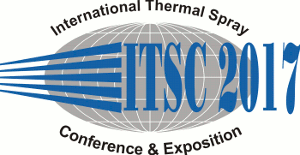
|
5416 |
|
Thursday, June 08, 2017, Hall 28 1:40 PM Equipment / Consumables & Powders, Wires, Suspensions II |
|
Development and application of binary suspensions in the ternary system Cr2O3-TiO2-Al2O3 for SHVOF spraying |
|
Annegret Potthoff* / Fraunhofer Institute for Ceramic Technologies and Systems (IKTS), Germany Robert Kratzsch / Fraunhofer Institute for Ceramic Technologies and Systems (IKTS) Dresden, Germany Nick Kulissa/ Fraunhofer Institute for Material and Beam Technology IWS Dresden, Germany Oliver Kunze/ Fraunhofer Institute for Material and Beam Technology IWS Dresden, Germany Maria Barbosa/ Fraunhofer Institute for Material and Beam Technology IWS Dresden, Germany Filofteia-Laura Toma/ Fraunhofer Institute for Material and Beam Technology IWS Dresden, Germany |
|
Next to ZrO2, the individual oxides and binary compositions in the system Cr2O3-TiO2-Al2O3 are the most used ceramic materials for thermally sprayed coating solutions. Cr2O3 coatings are character-ized by good sliding wear resistance, while Al2O3 coatings show excellent insulation behaviour and TiO2 has striking corrosion properties. In order to benefit from all and to combine these properties, coatings containing more than one oxide, are promising for applications in off-shore piston-rods or hydroelectric pistons. The conventional spraying process is limited to the availability of binary feedstock powders with defined compositions. However, using suspensions as feedstock for thermal spray offers the op-portunity for tailor-made compositions: within the triangle of Cr2O3-TiO2-Al2O3 each mixture of ox-ides can be created. The formulation of binary or ternary suspensions is based on the preparation of stable single-oxide suspensions, which will be later mixed in the appropriate concentration. This procedure requires the development of suspensions with interoperable components. Otherwise, particles and dis-solved organic additives, which are used to create colloid-chemical stable suspensions, may interact in liquid and form agglomerates. Besides low viscosity and high solid concentration, the homogenei-ty and sedimentation behaviour of binary water-based suspensions are also important. This work presents criteria for the selection of raw materials as well as aspects of the development of binary suspensions to be used in thermal spray. An industrial suitable procedure for their prepa-ration will be discussed. Coatings sprayed using the developed suspensions and high velocity oxy fuel flame spraying (SHVOF) will be presented and analysed in terms of their microstructure and phase composition. |